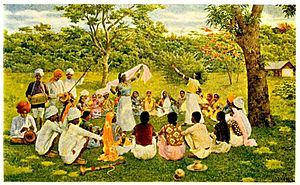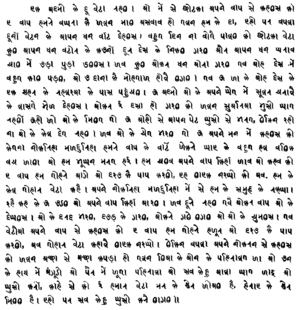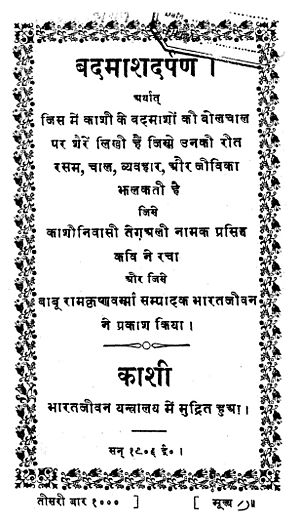Bhojpuri language facts for kids
Quick facts for kids Bhojpuri |
||||
|---|---|---|---|---|
| भोजपुरी | ||||

The word "Bhojpuri" in the Devanagari script
|
||||
| Native to | India and Nepal | |||
| Region | Bhojpur-Purvanchal | |||
| Ethnicity | Bhojpuris | |||
| Native speakers | 51 million, partial count (2011 census) (additional speakers counted under Hindi) |
|||
| Language family |
Indo-European
|
|||
| Early forms: |
Magadhi Prakrit
|
|||
| Dialects |
Northern Standard Bhojpuri
Western Standard Bhojpuri
Southern Standard Bhojpuri
Tharu Bhojpuri
Madheshi
Domra
Musahari
Caribbean Hindustani
· Trinidadian Hindustani · Guyanese Hindustani · Sarnami Hindoestani Nagpuriya Bhojpuri
Mauritian Bhojpuri
South African Bhojpuri (Naitali)
|
|||
| Writing system |
|
|||
| Official status | ||||
| Official language in | ||||
| Recognised minority language in | ||||
| Regulated by |
|
|||
| Linguasphere | 59-AAF-sa | |||
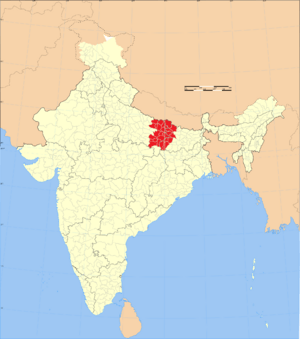
Bhojpuri-speaking regions of India
|
||||
|
||||
Bhojpuri (/ˌboʊdʒˈpʊəri/; ) is an Indo-Aryan language native to the Bhojpur-Purvanchal region of India and the Terai region of Nepal. It is chiefly spoken in western Bihar, eastern Uttar Pradesh and northwestern Jharkhand. It is an eastern Indo Aryan language and as of 2000[update] is spoken by about 5% of India's population. Bhojpuri is a descendant of Magadhi Prakrit and is closely related to Maithili, Magahi, Bangla, Odia, Assamese, etc. languages.
It is also a minority language in Fiji, Guyana, Mauritius, South Africa, Suriname and Trinidad and Tobago. Fiji Hindi, an official language of Fiji, is a variant of Awadhi and Bhojpuri spoken by the Indo-Fijians. Caribbean Hindustani, another variant of Bhojpuri is spoken by the Indo-Caribbean people. It has experienced lexical influence from Caribbean English in Trinidad and Tobago and in Guyana. In Suriname, languages that have lexically influenced it include Sranan Tongo Creole, Surinamese Dutch and English. Other dialects are spoken in Mauritius and South Africa, where its use is declining.
Contents
Name
The oldest presence of the word "Bhojpuri" is found as Bodjpooria in 1789 in the translator's preface of a book titled A Translation of the Sëir Mutaqherin, which is a translation of a Persian book written in 1780. The paragraph in which reads:
"Don't make so much noise" said of the them in his Bhojpooria idiom, "we go to-day with the Frenghees, but we all are servant to Chëyt Singh, and may come back tomorrow with him and then question will not be about your roots, but about your wives and daughters."
The word Bhojpuri is derived from Bhojpur. After the conquest of Chero and Ujjainiya Rajputs in 12th century, who were the descendants of Raja Bhoj from Ujjain, Malwa, Madhya Pradesh captured Shahabad and named their capital Bhojpur (City of Raja Bhoj). The seat of their government was Bhojpur village which was near Dumraon in Buxar. Two villages named Chhotka Bhojpur and Barka Bhojpur still exist in Buxar, where the ruins of their Navratna Fortress still can be seen. Slowly the word Bhojpur became the synonyms of the Shahabad or Arrah region (Today's Bhojpur district, Buxar, Kaimur and Rohtas) and the adjective Bhojpuri or Bhojpuriya extended to mean the language or people of Bhojpur and even beyond it. Apart from Bhojpuri in the Eastern UP and Western Bihar, there were other names also for the language and people, at different places, the Bhojpuriya in Mughal armies were used to called Buxariya. In Bengal, they called Paschhimas (Westerners) and Bhojpuri people also called them Deshwali or Khoṭṭa, in upper provinces like Oudh they called Purabiya. Besides these, Banarasi, Chhaprahiya, and Bangarahi has also used for the language and People. Rahul Sankrityayan has suggested two names for it i.e. Mallika or Malli (due to ancient tribe of Malla) and Kashiki (due to ancient Kashi). The Girmityas who were taken to British colonies called it simply Hindustani or Hindi and it became Fiji Hindi in Fiji and Caribbean Hindustani in the Caribbean region.
History
Bhojpuri is a descendant of Magadhi Prakrit which started taking shape during the reign of the Vardhana dynasty. Bāṇabhaṭṭa, in his Harshacharita has mentioned two poets named Isānchandra and Benibhārata who used to write in local language instead of Prakrit and Sanskrit.
Initial period (700-1100 A.D.)
The earliest form of Bhojpuri can be traced in the Siddha Sahitya and Charyapada as early as 8th century A.D.. This period is also called as Siddha period.
1100 - 1400 A.D.
Between 11th to 14th century A.D. the Folklores like Lorikayan, Sorathi Birjabh, Vijaymal, Gopichand, Raja Bharthariar etc. came in to existence. Along with these the Nath Saint composed literature in Bhojpuri. In this period Bhojpuri language got changed and it's regional boundry came into existence.
The period of saints (1400-1700 A.D.)
In this period saints from different sects like Kabir, Dharni Das, Kina Ram, Dariya Saheb etc used Bhojpuri as their language of discourses. In the same period Arabic and Persian words came into Bhojpuri. The composition of folksongs are also said to be happened in this duration.
The research period (1800-1900 A.D.)
In this period Britishers became strong in India, who conducted Initial researches in Bhojpuri. The study of folk literature of Bhojpuri was done and the map of Bhojpuri region was made for the first time in this period. Another important event for the language was that, it became international language. Between 1838 and 1917 labourers from this region were taken to British Colonies like Fiji, Mauritius, Guyana, Trinidad and Tobago and South Africa, as well as the Dutch colony of Suriname as plantation workers. Music genres based in Bhojpuri folk music like Chutney music, Baithak Gana, Geet Gawanai and Lok Geet took birth in those countries.
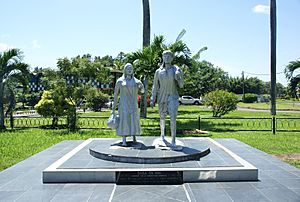
British scholars like Buchanan, Beames and George Abraham Grierson studied the language in details. Beames published the grammar of Bhojpuri for the first time in 1868. Grierson compiled and published the folksongs of Bhojpuri in 1884. He published the folklore of Bhojpuri and also made the dictionaries in Bhojpuri. He also conducted the Linguistic Survey of India.
Present period (1900 - present)
In 19th century, notable works like Devakshara Charita, Badmash Darpan were published. Bhikhari Thakur, in 20th century contributed significantly to Bhojpuri literature and theatre with his notable plays like Bidesiya, Beti Bechwa, Gabarghichor and novels like Bindia and Phulsunghi were published. In 1962, the first Bhojpuri film, Ganga Maiyya Tohe Piyari Chadhaibo was released and became the founding stone of the Bhojpuri film industry.
Geographic distribution
The Bhojpuri-speaking region covers the area of 73,000 square kilometres approximately in India and Nepal and borders the Awadhi-speaking region to the west, the Nepali-speaking region to the north, the Magahi and Bajjika-speaking regions to the east and the Magahi and Bagheli-speaking regions to the south. In Nepal, Bhojpuri is a major language. There are a number of Bhojpuri-speaking Muslims that are part of the Muhajir community in Pakistan, as well as in Bangladesh, where they are referred to as Stranded Pakistanis due to them speaking Bhojpuri and Urdu as their native tongue and not Bengali as most Bangladeshis do. They migrated to Bangladesh there during the Partition of India when the area was part of East Pakistan, before gaining independence as Bangladesh.
Bhojpuri is spoken by descendants of indentured labourers brought in the 19th and early 20th centuries for work in plantations in British colonies. These Bhojpuri speakers live in Mauritius, Fiji, South Africa, Trinidad and Tobago, Guyana, Suriname, Jamaica, and other parts of the Caribbean.
Classification
Bhojpuri is an Indo-European language and belongs to the Eastern Indo-Aryan group of the Indo-Aryan languages. The Magahi and Maithili languages of Eastern Indo-Aryan group are closest living relatives of Bhojpuri. Odia, Bengali and Assamese are also closely related. Bhojpuri along with Magahi and Maithili, are grouped together as the Bihari languages. Together with the other branches of Eastern Indo-Aryan, the Bihari languages are considered to be direct descendants of the Magadhi Prakrit.
Bhojpuri is classified as an Eastern Indo-Aryan Language because it has similar inflexion system to the other languages of the same family such as Bengali, Maithili and Odia. For example, the pronunciation of the vowel a is broad in Eastern Indo-Aryan languages, and sounds like o in Bengali, on moving westwards it becomes less broad but still can be differentiated from the sharp cut a in Middle Indo-Aryan. In Bhojpuri, the clear cut a and the drawled a, which sounds like aw in the word awl are present and the contrast between the two gives a different tone to the language. This drawled a is represented by Avagraha (ऽ), for instance, the word dekh'la, you see, is written as देेखऽलऽ. Other property of Eastern Indo Aryan languages is that the adjectives doesn't change with the noun. For instance moṭā feminine form moṭī in Hindi but in Bhojpuri only moṭ is used as in Bengali. The past and future tense in Bhojpuri is formed in same way as other Eastern Indo-Aryan Languages, by adding a suffix stating from -la and -ba respectively to the verb. Form example, I shall See, in Bengali is dekh-bo and in Bhojpuri is dekh-ab.
Some scholars has also divided the East Indo Aryan or Magadhan languages in to three sub-groups viz. Western, Central and Eastern. Bengali, Assamese, Odia belongs to Eastern Magadhan, Maithili and Magahi to Central and Bhojpuri to western. Bhojpuri is classified as Western Magadhan because it has some properties which are peculiar to itself and are not present in other Magadhan Languages. Some striking differences are:
- raürā or raüwā as an honorfic pronoun for second person along with the apne form is used Bhojpuri. apne form is their in other Magadhan Languages but raüwā is totally absent.
- Verb substantive in other Magadhan language is of -acch for but Bhojpuri has -baṭe and hawe.
- The simple present is made by Bhojpuri by adding a suffix starting from -la with the verb, but this is totally absent in the other languages of Magadhan group. Hence, he sees, is dēkhe-lā in Bhojpuri but in but dekhait-chhi in Maithili and dekhechhi in Bengali.
Sociolinguistically it is considered to be one of the seven main Hindi dialects.
Dialects
Bhojpuri has several dialects: Southern Standard Bhojpuri, Northern Standard Bhojpuri, Western Standard Bhojpuri, and Nagpuria Bhojpuri.
Southern Standard Bhojpuri is prevalent in the Shahabad district (Buxar, Bhojpur, Rohtas, and Kaimur districts) and the Saran region (Saran, Siwan and Gopalganj districts) in Bihar, the eastern Azamgarh (Ballia and Mau(Eastern Part) districts) and Varanasi (eastern part of Ghazipur district) regions in Uttar Pradesh, and in the Palamu division (Palamu and Garhwa districts) in Jharkhand. The dialect is also known as Kharwari. It can be further divided into Shahabadi, Chhaprahiya and Pachhimahi.
Northern Bhojpuri is common in the western Tirhut division (east and west Champaran districts) in Bihar, and Gorakhpur division (Deoria, Kushinagar, Gorakhpur, and Maharajganj districts) and Basti division (Basti, Sidharthanagar, and Sant Kabir Nagar districts) in Uttar Pradesh. It is also spoken in Nepal.
Western Bhojpuri is prevalent in the areas of Varanasi (Varanasi, Chandauli, Jaunpur, and the western part of Ghazipur district), Azamgarh (Azamgarh district, western part of Mau district) and Mirzapur, Sonbhadra, Sant Ravidas Nagar, and Bhadohi districts) in Uttar Pradesh. Banarasi is a local name for Bhojpuri, named after Banaras. Other names for Western Bhojpuri include Kashika, Purbi and Benarsi.
Nagpuria Bhojpuri is the southernmost popular dialect, found in the Chota Nagpur Plateau of Jharkhand, particularly parts of Palamu, South Chotanagpur and Kolhan divisions. It is sometimes referred to as Sadari.
A more specific classification recognises the dialects of Bhojpuri as Bhojpuri Tharu, Domra, Madhesi, Musahari, Northern Standard Bhojpuri (Basti, Gorakhpuri, Sarawaria), Southern Standard Bhojpuri (Kharwari), Western Standard Bhojpuri (Benarsi, Purbi) and Nagpuriya Bhojpuri.
Phonology
| Front | Central | Back | ||
|---|---|---|---|---|
| Close | i ɪ | u | ||
| Close-mid | e | o | ||
| Mid | ə | |||
| Open-mid | ɛ | ɔ | ||
| Open | æ | a | ||
| Labial | (Denti-) Alveolar |
Retroflex | (Alveolo-) palatal |
Velar | Glottal | ||
|---|---|---|---|---|---|---|---|
| Nasal | m | n | ɳ | ɲ | ŋ | ||
| Stop/ Affricate |
voiceless | p | t̪ | ʈ | tɕ | k | |
| voiced | b | d̪ | ɖ | dʑ | ɡ | ||
| aspirated | pʰ | [[Error using : IPA symbol "t̪ʰ" not found in list|t̪ʰ]] | ʈʰ | tɕʰ | kʰ | ||
| breathy voiced | bʱ | d̪ʱ | ɖʱ | dʑʱ | ɡʱ | ||
| Fricative | s | h | |||||
| Rhotic | plain | ɾ | ɽ | ||||
| breathy | [[Error using : IPA symbol "ɾʱ" not found in list|ɾʱ]] | [[Error using : IPA symbol "ɽʱ" not found in list|ɽʱ]] | |||||
| Approximant | w ~ ʋ | l | j | ||||
Among the seven languages which are sociolinguistically often counted as Hindi dialects (Haryanvi, Braj, Awadhi, Bhojpuri, Bundeli, Bagheli, and Kannauji), Bhojpuri has the most allophonic variations in vowels.
Bhojpuri has 6 vowel phonemes and 10 vocoids. The higher vowels are relatively tense, and the lower vowels are relatively lax. The language has 31 consonant phonemes and 34 contoids (6 bilabial, 4 apico-dental, 5 apico-alveolar, 7 retroflex, 6 alveo-palatal, 5 dorso-velar, and 1 glottal).
Linguist Robert L. Trammell published the phonology of Northern Standard Bhojpuri in 1971. According to him, the syllable system is peak type: every syllable has the vowel phoneme as the highest point of sonority. Codas may consist of one, two, or three consonants. Vowels occur as simple peaks or as peak nuclei in diphthongs. The intonation system involves 4 pitch levels and 3 terminal contours.
Grammar
According to George Abraham Grierson, the grammar of Bhojpuri is simpler than other languages of the same family. Nouns in Bhojpuri have three forms: short, long and redundant. The adjectives of nouns do not change with genders. Plurals are made by adding either the suffix -na or ni with the nouns or adding the multitudes such as sabh (all) or lōg (people).
Examples:
| Definition | Singular Form | Plural Form |
|---|---|---|
| House | ghar | gharan |
| Horse | ghoṛā | ghoṛan |
| Boy | laïkā | laïkan/laïka sabh |
| King | rājā | rājā lōg |
Except few instances the Verb forms of Bhojpuri depend only on the subject and the object has no effect on it. Unlike other Eastern Indo-Aryan languages, Bhojpuri has a different verb form for the present tense, which corresponds to the Future forms of Nepali. It is formed by adding the suffix -lā to the present subjunctive. Therefore, for the verb to see the Bhojpuri verb is dekhe and the present form is dhekhelā, which is peculiar to itself and is not found in other languages of the same family like Magahi (dekhaït haï), Maithili (dekhaït achi) and Bengali (dekhechī). The Verbs forms of second person singular (dekh'be; you will see) is considered vulgar in Bhojpuri, plural form (dekhab') is used in general. When it is desired to show respect the first person singular form (dekhab; I will see) is used instead of second person plural (dekhab'). To show plural number the suffix -sa' or -ja is also used with the 2nd and third person forms, thus dekhe-la'-sa is they see. The present perfect form is made by adding ha' to the past form. Thus, ham dekh'li (I saw) is the past from and its present perfect form is ham dekh'li ha' (I have seen). Past perfect in regular verbs are made by adding the suffix -al to the verb (dekh - dekhal), but in some cases it has irregular forms like kar (kail), mar (mual) etc.
Numerals of Bhojpuri take the classifier gō and ṭhō, which emphasises the countability and totality both. To show inclusiveness and exclusiveness, Bhojpuri used the suffixes -o and -e as in ham āmo khāïb (I will eat mangoes too) verses ham āme khāïb (I will eat only mangoes). These suffixes can be added to any lexical category such as numerals, adjectives etc.
The auxiliaries in Bhojpuri are formed on five bases viz. ha, ho, hokh, bāṭ, rah. These also act as the Copula. The bāṭ form provides for the tenses and the hokh or ho form provides for the modes, where as rah is the past of other three.
Writing system
Bhojpuri was historically written in Kaithi script, but since 1894 Devanagari has served as the primary script. Kaithi has variants as the locality changes, the three classified varianta are Tirhuti, Magahi and Bhojpuri variants. The Bhojpuri variant is used for writing Bhojpuri. Kaithi is now rarely used for Bhojpuri.
Kaithi script was used for administrative purposes in the Mughal era for writing Bhojpuri, Awadhi, Maithili, Magahi, and Hindustani from at least the 16th century up to the first decade of the 20th century. Government gazetteers report that Kaithi was used in a few districts of Bihar throughout the 1960s. Bhojpuri residents of India who moved to British colonies in Africa, the Indian Ocean, and the Caribbean in the 19th and early 20th centuries used both Kaithi and Devanagari scripts.
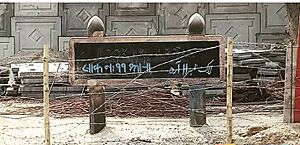
By 1894 both Kaithi and Devanagari became common scripts to write official texts in Bihar. At present almost all Bhojpuri texts are written in Devanagari, even in islands outside of India where Bhojpuri is spoken. In Mauritius, Kaithi script was historically considered informal, and Devanagari was sometimes spelled as Devanagri. In modern Mauritius, the major script is Devanagari.
Politeness
Bhojpuri syntax and vocabulary reflects a three-tier system of politeness. Any verb can be conjugated through these tiers. The verb to come in Bhojpuri is aana and the verb to speak is bolna. The imperatives come! and speak! can be conjugated in five ways, each marking subtle variation in politeness and propriety. These permutations exclude a host of auxiliary verbs and expressions, which can be added to verbs to add another degree of subtle variation. For extremely polite or formal situations, the pronoun is generally omitted.
| Literary | [teh] āō | [teh] bōl |
|---|---|---|
| Casual and intimate | [tu] āō | [tu] bōl |
| Polite and intimate | [tu] āv' | [tu] bōl' |
| Formal yet intimate | [rau'ā] āīñ | [rau'ā] bōlīñ |
| Polite and formal | [āpne] āīñ | [āpne] bōlīñ |
| Extremely formal | āwal jā'e | bōlal jā'e |
Similarly, adjectives are marked for politeness and formality. The adjective your has several forms with different tones of politeness: tum (casual and intimate), "tōhār" (polite and intimate), "t'hār" (formal yet intimate), rā'ur (polite and formal) and āpke (extremely formal). Although there are many tiers of politeness, Bhojpuri speakers mainly use the form tu to address a younger individual and raua for an individual who is older, or holds a higher position in workplace situations.
Status
Greater official recognition of Bhojpuri, such as by inclusion in the Eighth Schedule to the Constitution of India, has been demanded. In 2018, Bhojpuri was given second-language status in Jharkhand state of India.
Bhojpuri is taught in matriculation and at the higher secondary level in the Bihar School Education Board and the Board of High School and Intermediate Education Uttar Pradesh. It is also taught in various universities in India, such as Veer Kunwar Singh University, Banaras Hindu University, Nalanda Open University, and Dr. Shakuntala Misra National Rehabilitation University.
Literature
Lorikayan, the story of Veer Lorik contains Bhojpuri folklore from Eastern Uttar Pradesh. Bhikhari Thakur's Bidesiya is a play, written as a book. Phool Daliya is a well-known book by Prasiddh Narayan Singh. It comprises poems of veer ras (A style of writing) on the theme of azaadi (Freedom) about his experiences in the Quit India movement and India's struggle with poverty after the country gained independence.
Media
The first journal to be published in Bhojpuri was Bagsar Samāchar which was published in 1915, but was closed in 1918. The first Bhojpuri weekly was published on 15 August 1947. Bhojpuri journalism rose massively in 1960s and 1970s, Bhojpuri Parivar (Patna), Bhojpuri Mandal (Motihari), Bhojpuri Samaj (Arrah) were some prominent journals of that time. Many Bhojpuri magazines and papers are published in Bihar, Jharkhand, and Uttar Pradesh. Several Bhojpuri newspapers are available locally in northern India. Parichhan is a contemporary literary-cultural Maithili-Bhojpuri magazine, published by a Maithili-Bhojpuri academy and the government of Delhi, and edited by Parichay Das. The Sunday Indian, Bhojpuri is a regular national news magazine in Bhojpuri. Aakhar is a monthly online Bhojpuri literature magazine. Other media in Bhojpuri include Lok Lucknow, and the channels Mahuaa TV and Hamar TV. Bhojpuri Wikipedia was launched in 2003. On 22 May 2022, Google Translate added Bhojpuri as one of their languages.
Vocabulary
Bhojpuri vocabularies have similarity with other Indo Aryan languages and also have loanwords from Persian. Tiwari, have classified the words of Bhojpuri in to 6 parts:
- Words of Sanskrit origin
- Words with untraceable origin
- Words borrowed from other Indo-Aryan Languages
- Sanskrit words either in original or modified form
- Words of non-Aryan Indian origin
- Foreign Origin (Arabic, British etc.)
Words of Persian origin are roughly classified under the following head:
- Words pertaining to kingly states: amīr, kābū, hajūr
- Words relating to Revenue, Administration and Law: darogā, hak, huliyā
- Words relating to Islam: Allāh, tobā, mahjid
- Words of intellectual culture,music, education: ilīm, ijjat, munsi
- Words of material culture: kāgaj, kismis, sāl
Since, Bengal has been one of the greatest centre for Bhojpuri-speaking people, Bhojpur has taken a number of words from Bengali. It is also probable that words of European original came in Bhojpuri through Bengali.
Weekdays
| English | Bhojpuri (Latin script) | भोजपुरी (देवनागरी लिखाई) |
|---|---|---|
| Sunday | Eitwaar | एतवार |
| Monday | Somaar | सोमार |
| Tuesday | Mangar | मङर |
| Wednesday | Budhh | बुध |
| Thursday | Biphey | बियफे |
| Friday | Sook | सूक |
| Saturday | Sanichar | सनिचर |
Common phrases
| English | Bhojpuri | भोजपुरी |
|---|---|---|
| Hello | Raam Raam/Parnaam | राम राम/परनाम |
| Welcome/Please come in | Aain na | आईं ना |
| How are you? | Ka haal ba?/Kaisan hava? | का हाल बा?/कइसन हवऽ? |
| I'm good. And you? | Hum theek baani. Aur rauwa?/Hum theek hañi. Aur aap? | हम ठीक बानी। अउर रउवा?/हम ठीक हईं। अउर आप? |
| What is your name? | Tohaar naav ka ha?/Raur naav ka ha? | तोहार नाँव का ह?/राउर नाँव का ह? |
| My name is ... | Hamar naav ... ha | हमार नाँव ... ह |
| What's up? | Kaa hot aa? | का होता? |
| I love you | Hum tohse pyaar kareni/Hum tohra se pyaar kareni | हम तोहसे प्यार करेनी/हम तोहरा से प्यार करेनी |
NUMBER
English। Bhojpuri
1 - One १= ek - एक
2= Two २= du - दु
3= Three ३= teen =तीन
4= four ४= char= चार
5= five ५= pan = पान
6= six ६= chhav= छव
7= seven। ७= sat= सात
8=eight ८= aath= आठ
9= nine ९= nav = नव
10= ten १०= das= दस
100= one hundred १००= ek say = एक सव
500= five hundred ५००= pan say = पान सव
1000= one thousand १०००= ek hajar = एक हजार
Example text
The following is Article 1 of the Universal Declaration of Human Rights in four languages:
- Bhojpuri (Devanagari) – अनुच्छेद १: सबहि लोकानि आजादे जन्मेला आउर ओखिनियो के बराबर सम्मान आओर अधिकार प्राप्त हवे। ओखिनियो के पास समझ-बूझ आउर अंत:करण के आवाज होखता आओर हुनको के दोसरा के साथ भाईचारे के बेवहार करे के होखला।
- Sarnámi Hindustani (a dialect of Caribbean Hindustani) – Aadhiaai 1: Sab djanne aadjádi aur barabar paidaa bhailèn, iddjat aur hak mê. Ohi djanne ke lage sab ke samadj-boedj aur hierdaai hai aur doesare se sab soemmat sè, djaane-maane ke chaahin.
See also
 In Spanish: Idioma bhoshpuri para niños
In Spanish: Idioma bhoshpuri para niños
- Culture of Bhojpuri Region
- Bhojpuri cinema


